Cleaning under the toilet base is often overlooked in routine bathroom cleaning, yet it is crucial for maintaining a healthy and hygienic environment. This neglected area can harbor bacteria, mold, and unpleasant odors, contributing to an unclean feel in what should be a sanitary space.
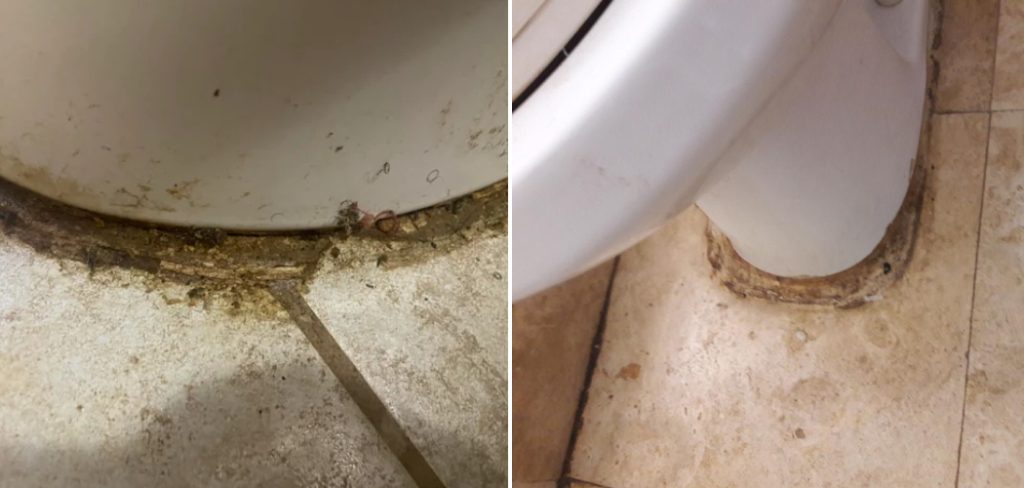
Understanding how to clean under toilet base effectively elevates your bathroom’s cleanliness and addresses hidden health risks and aesthetic concerns. This article aims to guide you through various methods and techniques to ensure a thorough cleaning process under the toilet base.
By exploring various approaches, from conventional to alternative cleaning methods, this guide will equip you with the knowledge to tackle this challenging task, ensuring your bathroom remains a clean, fresh, and inviting space for all who use it.
Understanding the Importance of Cleaning Under Toilet Base
A. Hygiene Considerations: Potential Health Risks of Neglecting Under Toilet Base Cleaning
Neglecting the cleanliness of the area under the toilet base can lead to substantial hygiene issues within your bathroom.
This damp and dark environment is an ideal breeding ground for harmful bacteria and mold, posing serious health risks to households. Prolonged exposure to such conditions can result in infections, skin irritations, and respiratory problems. Regular cleaning mitigates these risks, ensuring the bathroom remains a safe and healthy space for all.
B. Odor Control: Addressing Unpleasant Smells and Preventing Bacterial Growth
Unpleasant odors are a common complaint in bathrooms, often originating from areas that are not regularly cleaned, such as under the toilet base. These odors are a telltale sign of bacterial growth and decaying organic matter.
By maintaining a clean under-toilet area, homeowners can significantly reduce the presence of these smells, thus improving the overall freshness of the bathroom. Effective odor control involves cleaning and disinfecting the area to kill bacteria responsible for the odors.
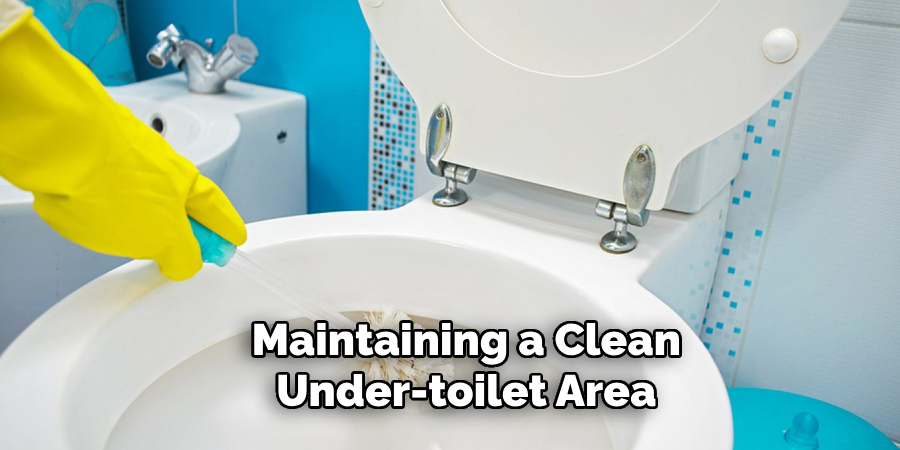
C. Aesthetic Appeal: Enhancing the Appearance of the Bathroom and Preventing Stains
A clean bathroom is about hygiene, odor control, and aesthetics. Stains, grime, and mold under the toilet base can be off-putting and contribute to a neglected appearance. Regular cleaning prevents the buildup of these unsightly marks, preserving the bathroom’s visual appeal. Additionally, a well-maintained bathroom can potentially increase the value of your home, making it an important aspect of household upkeep.
Preparation and Safety Measures
Before commencing cleaning under the toilet base, preparing adequately by gathering the necessary supplies ensures a smooth and efficient operation. This preparation phase is pivotal as it sets the stage for a safe and effective cleaning routine.
A. Gathering Necessary Supplies: Brushes, Cleaning Solutions, and Protective Gear
Begin by assembling all required supplies. These include a variety of brushes (such as a stiff-bristled brush for scrubbing and a smaller detail brush for tight spots), suitable cleaning solutions (like bleach-based cleaners for disinfecting or eco-friendly alternatives for those preferring a greener approach), and protective gear.
Protective gear is essential to safeguard your health and should include gloves, goggles, and possibly a mask to avoid inhaling fumes from cleaning chemicals.
B. Safety Precautions: Turning off Water Supply, Ensuring Ventilation, and Using Non-Toxic Cleaners
Safety cannot be overstated when dealing with water and chemicals. Start by turning off the water supply to the toilet to prevent any accidental spills or leaks. Ensure the bathroom is well-ventilated to circulate air and dissipate any harmful fumes from cleaning solutions.
For open windows, use exhaust fans, or even consider using a fan to maintain airflow. Choosing non-toxic, biodegradable cleaners is advisable for those sensitive to strong chemicals or concerned about environmental impact. These precautions provide a safer cleaning environment and contribute to the overall well-being of your household and the planet.
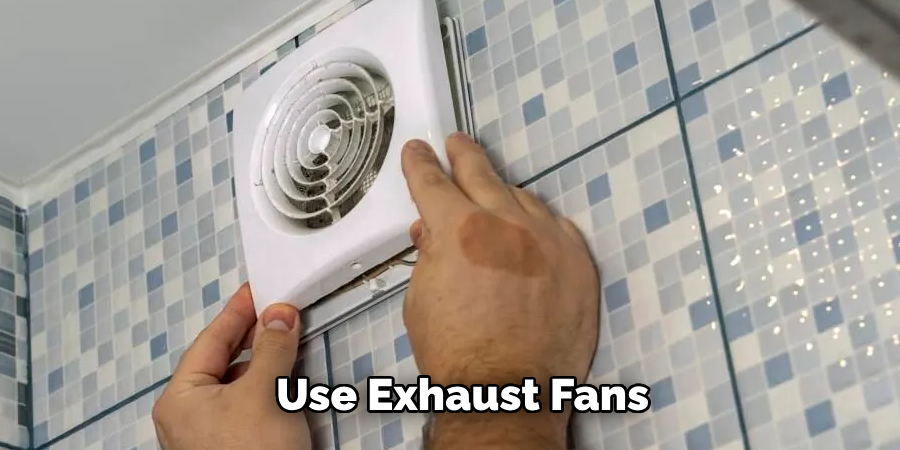
How to Clean Under Toilet Base: Step-by-Step Cleaning Guide
Cleaning under the toilet base is essential for maintaining hygiene, controlling odors, and ensuring the aesthetic appeal of your bathroom. This detailed step-by-step guide will walk you through the entire process, highlighting effective methods and safety precautions.
A. Removing Toilet Tank: Ensuring Proper Access to Underneath the Toilet Base
The first step involves gaining appropriate access to clean thoroughly under the toilet base. In some cases, this might require temporarily removing the toilet tank. Start by shutting off the water supply, then flush the toilet to drain the tank.
Unscrew the water supply line and the bolts securing the tank to the toilet. Carefully lift the tank and place it aside on a towel or a soft surface to avoid damage. This step ensures unobstructed access to areas that are often missed during regular cleaning.
B. Clearing Debris: Using Brushes, Scrubbers, and Vacuum Cleaners to Remove Dirt and Grime
With the tank removed, begin clearing any visible debris around the toilet base. Use stiff-bristled brushes and scrubbers to loosen dirt and grime. For smaller particles or in tighter spaces, a handheld vacuum cleaner can be an effective tool. Pay special attention to the area where the toilet meets the floor, as this is a common site for the accumulation of hair, dust, and other debris.
C. Disinfecting Surfaces: Applying Cleaning Solutions and Sanitizers to Eliminate Bacteria and Germs
Once debris is cleared, it’s time to disinfect. Apply a generous amount of your chosen cleaning solution around the toilet base, ensuring it reaches under the edges where germs are likely to harbor. Leave the solution to sit for the recommended time to effectively kill bacteria and germs. For eco-friendly alternatives, consider using a solution of vinegar and water or hydrogen peroxide.
D. Addressing Hard-to-Reach Areas: Reaching Nooks and Crannies with Specialized Tools and Techniques
Hard-to-reach areas require special attention. Use a small brush or an old toothbrush to scrub tight spaces under the toilet base and around any bolts or crevices. For extremely narrow gaps, consider using a cotton swab or thin cloth wrapped around a flat tool to reach inside and ensure thorough cleaning.
E. Rinsing and Drying: Flushing with Water and Allowing Sufficient Time for Drying Before Reassembling
After scrubbing and disinfecting, rinse the area thoroughly with water to remove any residual cleaning solution. Use a spray bottle filled with clean water for an even rinse, then pat dry with a towel or allow the area to air-dry completely.
Ensure the surface under the toilet base is completely dry before reassembling the toilet tank and reconnecting the water supply. Finally, perform a flush test to ensure everything works correctly, making your bathroom cleaner, fresher, and more hygienic.
Alternative Cleaning Methods
Beyond traditional cleaning techniques, several alternative methods can offer both efficacy and safety in maintaining a pristine bathroom environment. These alternatives range from leveraging the sanitizing power of steam to employing natural substances that are gentle on the environment while still potent against grime and bacteria. Professional cleaning services provide a comprehensive, worry-free solution for those seeking a more hands-off approach.
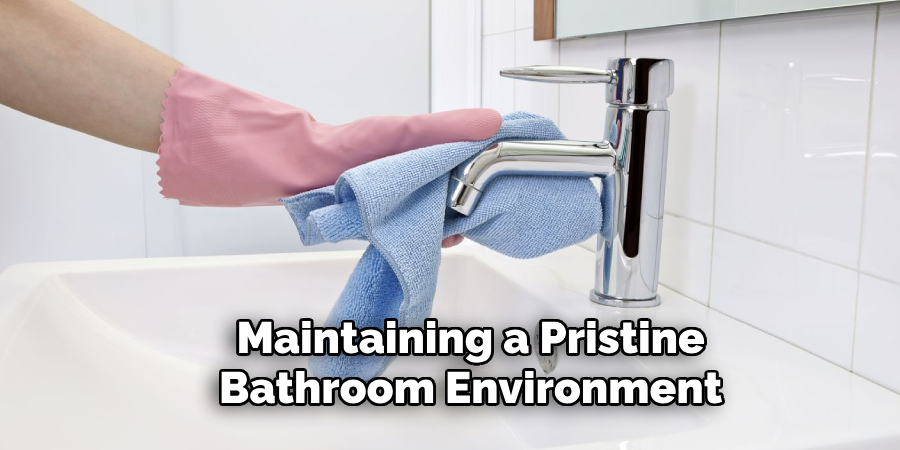
A. Steam Cleaning: Harnessing the Power of Steam for Deep Cleaning and Sanitization
Steam cleaning involves the use of vaporized water to clean and disinfect surfaces. This method is especially effective for bathroom cleaning because it can reach into crevices that are otherwise difficult to clean.
The high temperature of the steam not only loosens dirt and grime but also kills germs, mold, and bacteria, making it an ideal choice for those seeking a thorough cleaning without the use of harsh chemicals. Most steam cleaners come with various attachments suitable for different surfaces and specific cleaning needs under the toilet base.
B. Natural Remedies: Using Vinegar, Baking Soda, and Lemon Juice for Eco-Friendly Cleaning
Natural remedies offer an effective and safe alternative for those who prefer a more environmentally friendly approach. Vinegar, for instance, is an excellent disinfectant that can tackle most bathroom germs and bacteria. Combined with baking soda, it creates a potent fizzing action to break down tough stains and grime.
Lemon juice, with its natural acidity, is great for removing limescale and enhancing shine. These natural ingredients can be used individually or in combination to create powerful, non-toxic cleaning solutions for the bathroom.
C. Professional Services: Exploring Options for Professional Cleaning Services and Assistance
Sometimes, despite our best efforts, the task of deep cleaning the bathroom, especially areas as challenging as under the toilet base, can be daunting. This is where professional cleaning services come in. Professional cleaners have the expertise, tools, and products to efficiently clean and sanitize even the most neglected bathrooms.
They can also offer valuable advice on how to maintain cleanliness over time. Opting for professional cleaning services saves time and effort and ensures a level of cleanliness and hygiene that might be hard to achieve on one’s own.

Maintenance Tips for Prolonged Cleanliness
Maintaining the cleanliness of the bathroom, particularly around the toilet base, demands consistent effort and preventive strategies. Ensuring this area remains clean not only contributes to the overall hygiene of the bathroom but also prevents the development of odors and stains. Incorporating a few simple practices into your cleaning routine can significantly extend the time between deep cleanings.
A. Regular Inspection: Checking for Signs of Accumulated Dirt and Moisture
Frequent inspections can help catch issues before they become problematic. Pay attention to signs of accumulated dirt, moisture, or mildew around the toilet base. Early detection of these signs allows for prompt cleaning actions, thereby preventing the formation of stubborn stains or mold growth. Look specifically in corners and under edges where moisture might collect unnoticed.
B. Scheduled Cleaning Routine: Establishing a Cleaning Schedule to Prevent Build-Up
Consistency is key to maintaining cleanliness. Establishing a scheduled cleaning routine ensures that cleaning the toilet base and surrounding areas becomes a habit rather than a dreaded chore. Whether it’s a weekly or bi-weekly task, having it on the calendar prompts action and prevents the build-up of grime and bacteria. This schedule should include surface cleaning and a check on hard-to-reach areas that might need periodic attention.
C. Preventive Measures: Using Toilet Mats and Sealants to Minimize Future Mess and Stains
Implementing preventive measures can significantly reduce the effort required in future cleanings. Using toilet mats helps capture dirt and moisture before it reaches the toilet base.
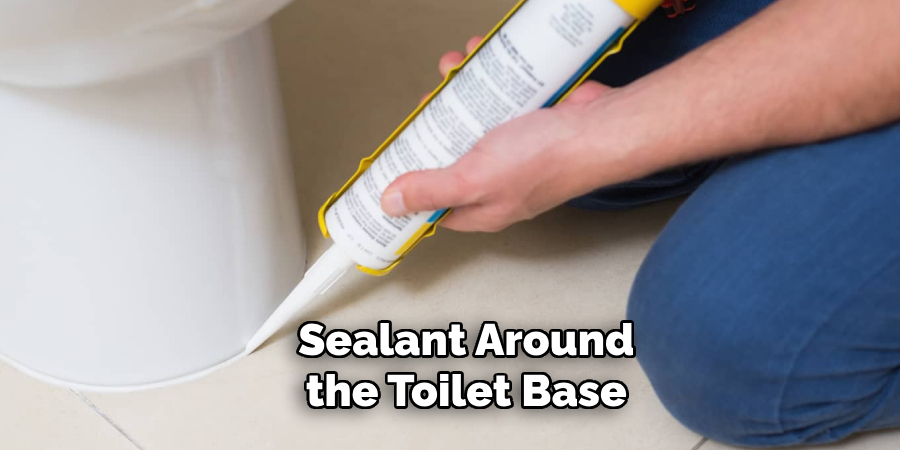
Additionally, applying a silicon-based sealant around the toilet base can prevent water and waste from seeping underneath, reducing the risk of mold growth and making cleaning easier. These simple adjustments contribute greatly to keeping the bathroom cleaner for longer periods.
Troubleshooting Common Issues
Maintaining a pristine bathroom is not without its challenges. Occasionally, stubborn stains and water leakages can affect the cleanliness of the space, particularly around the toilet base. Addressing these issues promptly with effective techniques ensures the bathroom remains in top condition.
A. Dealing with Stubborn Stains: Tips and Techniques for Removing Tough Stains
Stubborn stains, whether from hard water, waste, or mold, can be an eyesore and detract from the overall hygiene of the bathroom. Using a mixture of vinegar and baking soda can be particularly effective for hard water stains. Apply the paste to the stained area, leave it for 15 minutes, then scrub with a stiff brush.
A bleach-based cleaner might be necessary for tougher stains, like mold or mildew. Apply sparingly, ensuring the area is well-ventilated, and always wear protective gloves. It’s important to test any cleaner on a small, inconspicuous area first to avoid damaging the surface.
B. Managing Water Leakage: Identifying and Addressing Potential Causes of Leakage Under Toilet Base
Water leakage around the toilet base poses a cleanliness issue and can lead to structural damage if left unaddressed. The first step in tackling leakage is identifying its source. Often, the wax ring that seals the connection between the toilet and the floor drain can deteriorate, allowing water to escape.
Replacing the wax ring requires removing the toilet, which might necessitate professional help. Additionally, check if the leak is actually coming from a loose supply line or faulty tank hardware, which is easier to fix. Regular maintenance checks can preempt major leakage issues, saving time and money in the long run.
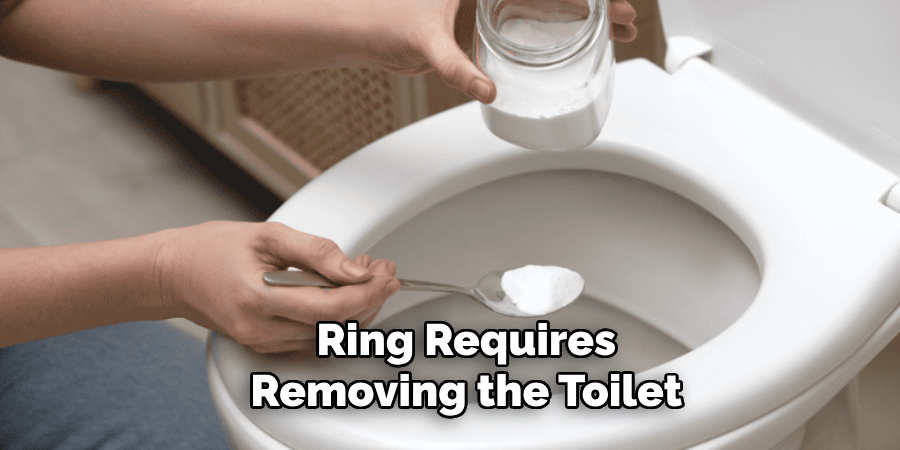
Frequently Asked Questions
Q1: How Often Should I Deep Clean My Bathroom?
A1: The frequency of deep cleaning your bathroom can vary depending on usage and the number of people in the household. However, aiming for a deep clean every 4 to 6 weeks is a good practice. This helps maintain hygiene and prevents the buildup of soap scum, limescale, and mildew.
Q2: Can Natural Cleaning Solutions Disinfect as Well as Commercial Cleaners?
A2: Many natural cleaning solutions, such as vinegar and baking soda, possess properties that can effectively clean and disinfect surfaces. However, for areas needing disinfection from specific bacteria or viruses, it’s advisable to use a cleaner designated as a disinfectant by health authorities.
Q3: What Should I Do if The Stains Around the Toilet Base Won’t Come Off After Trying the Suggested Methods?
A3: If stubborn stains persist, consider gently using a pumice stone on the stained area. It’s safe and can remove stains without harsh chemicals on non-porous surfaces. If the stain remains, it may be time to seek professional help, as the issue might be more than surface-level.
Q4: How Can I Tell if The Toilet Base Leakage Is Due to A Faulty Wax Ring?
A4: Symptoms of a faulty wax ring include visible water or moisture around the toilet base, a noticeable sewage smell, and loose or wobbly toilet fixtures. Replacing the wax ring may be necessary if you experience any of these indicators.
Q5: Are Professional Cleaning Services Worth the Cost for Bathroom Maintenance?
A5: Opting for professional cleaning services can be a valuable investment, especially for deep cleaning sessions or handling persistent issues like mold, mildew, and deep-set stains. Professionals have the tools and knowledge to ensure a thorough cleaning. However, most tasks can be handled with a good routine and the right products for regular maintenance.
Q6: Is It Necessary to Use a Separate Cleaning Product for The Toilet Base, or Will an All-Purpose Cleaner Suffice?
A6: An all-purpose cleaner can be effective for routine cleaning of the toilet base. However, using a specialized bathroom cleaner can speed up the process and provide better results for tougher stains and grime. It’s also important to ensure that any cleaner used is safe for the specific surface and is not abrasive or damaging. Always read the instructions and test on a small area first before using a new product.
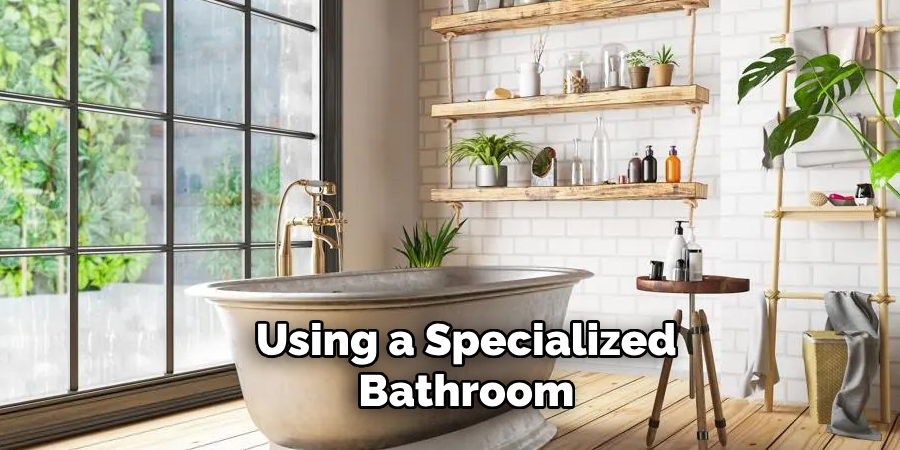
Conclusion
In this guide, we’ve traversed the essential terrain of how to clean under toilet base, underscoring the critical importance of regular cleaning and maintenance in this often-overlooked area. From employing natural remedies and professional services to adopting preventative measures and troubleshooting common issues, we’ve provided a comprehensive toolkit to ensure your bathroom remains a beacon of cleanliness and hygiene.
We encourage you to take these insights off the page and into your home; implementing these strategies can significantly transform your bathroom into a cleaner, healthier environment. Remember, routine care under the toilet base enhances the aesthetic appeal of your bathroom and plays a vital role in the overall sanitation and comfort of your living space.
In closing, maintaining a fresh and hygienic bathroom space is undoubtedly worthwhile. The peace of mind and satisfaction that come from a sparkling, clean bathroom rejuvenates the physical space and your personal well-being. Armed with the knowledge of how to clean under toilet base effectively, you are well-equipped to ensure your bathroom remains a pristine and welcoming haven for all who enter.